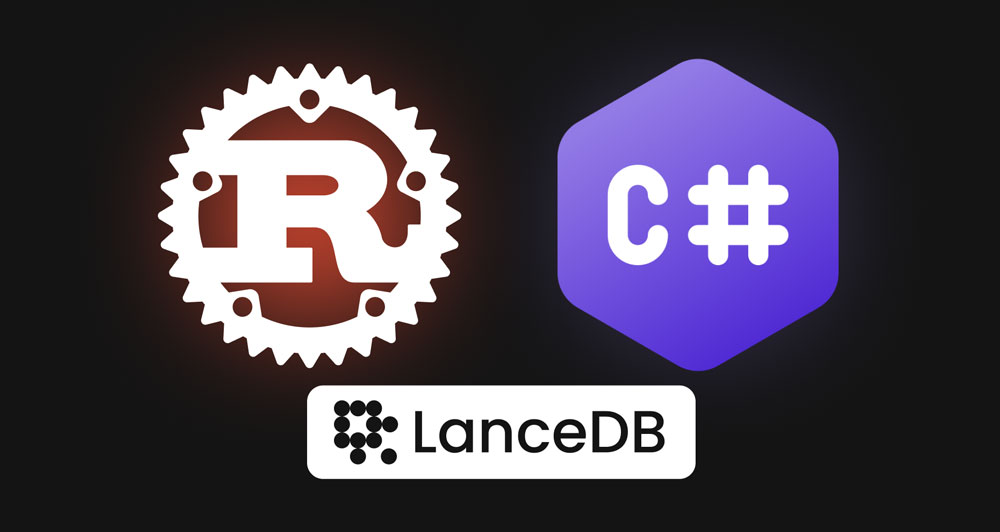Case Study
How Rust and .NET Came Together to Power AI at Scale
How Ardan Labs helped a telecom company integrate a Rust-based vector database with their .NET AI infrastructure—unlocking high-performance RAG without changing existing tools.

Built to Perform
We created a seamless C# integration layer for LanceDb, a Rust-based vector database. This allowed a major telecom provider to incorporate high-performance Retrieval Augmented Generation (RAG) into their AI pipeline—without needing to write or understand Rust.
Collaborating for Success
The client had chosen LanceDb for its raw performance. But without C# bindings or a built-in network interface, plugging it into their system was a real challenge. That’s where Ardan Labs stepped in.
Results That Matter
With Rust under the hood and .NET at the surface, the team unlocked high-throughput performance and laid the foundation for faster, more scalable AI workflows—all without changing their existing tools.
We delivered a customized integration that bridged Rust’s power with .NET’s accessibility, unlocking the full value of LanceDb in their existing codebase.
Overview
The Challenge: Bringing Rust Performance to a C# Ecosystem
LanceDb is engineered for speed, concurrency, and efficient semantic search—thanks to its Rust foundation and async-first architecture. However, its lack of a network service mode and primary focus on Python made it difficult to adopt for teams outside the Python ecosystem.
Our client’s AI infrastructure was built in C#. Replacing their stack wasn’t an option. They needed a way to access LanceDb’s performance while keeping their .NET development model intact.
The Goal: Performance Without Compromise
The engineering team wanted more than just access to LanceDb—they needed a stable, idiomatic integration that worked with their tools and supported:
- Seamless async Rust interoperability from .NET
- Clean, familiar C# interfaces
- Predictable, production-grade behavior under load
Our Solution: Engineering the Bridge
Phase 1: A C-Compatible Rust Library
We wrapped LanceDb in a Rust library with a C-style interface, carefully managing async initialization, threading, and memory boundaries. This allowed .NET code to invoke high-performance operations in Rust with safety and clarity.
Key features included:
- Thread-safe request routing to async Rust tasks
- Clean error propagation and resource management across the FFI boundary
- Minimal, well-documented function surfaces to simplify usage
Phase 2: Native C# Integration Layer
On the .NET side, we built a dedicated C# wrapper library that connected to the Rust binary. It handled memory ownership, marshaling, and surfaced LanceDb functionality through a modern, ergonomic API.
We focused on:
- Efficient data translation across native boundaries
- Catching and reporting Rust errors cleanly in C#
- Supporting safe parallel usage in real-world applications
Beyond the Bridge: Enhancing the Platform
LanceDb’s most advanced features were available only in its Python SDK. These were essential for production use, so we extended the Rust core and exposed the necessary functionality to C#.
This ensured the engineering team could work entirely within their preferred environment—without compromises or workarounds.
Outcomes That Made a Difference
Rapid Prototyping
Teams were able to ship features faster using tools they already knew, without sacrificing performance.
Operational Confidence
The integration was reliable from day one. With robust error handling, resource cleanup, and predictable behavior, it was ready for production immediately.
High-Performance AI at Scale
The combination of Rust’s async engine and .NET’s rich development ecosystem enabled efficient, high-concurrency inference with minimal latency and overhead.
Building for the Future
From the outset, we designed the solution for long-term sustainability, not just short-term results. We worked closely with the client’s engineering leadership to:
- Document every integration point
- Build reusable examples and helper libraries
- Enable future extensions with minimal friction
The result: full ownership for their internal teams, along with the clarity and confidence to evolve the platform independently.
Rethinking What’s Possible in AI Infrastructure
This project shows what’s possible when systems-level expertise meets application-level pragmatism.
Integration isn’t just about making things connect—it’s about unlocking performance, enhancing maintainability, and empowering developers to move fast without rewriting their workflows.
Rust and C# aren’t usually part of the same system. But with careful design and deep collaboration, they can work together to push the boundaries of what AI infrastructure can achieve.
Let's Build What's Next
At Ardan Labs, we help teams overcome platform constraints, scale smarter, and build reliable systems that grow with their needs.
Have a hard technical problem?
Let's talk about how we can help Explore our Consulting services
From the Lab
Where ideas get tested and shared. From the Lab is your inside look at the tools, thinking, and tech powering our work in Go, Rust, and Kubernetes. Discover our technical blogs, engineering insights, and YouTube videos created to support the developer community.
Explore our content:
Getting Friendly With CPU Caches
Updated on

William Kennedy
16 Years of Go: A Programming Language Built to Last
Updated on

Ardan Labs


